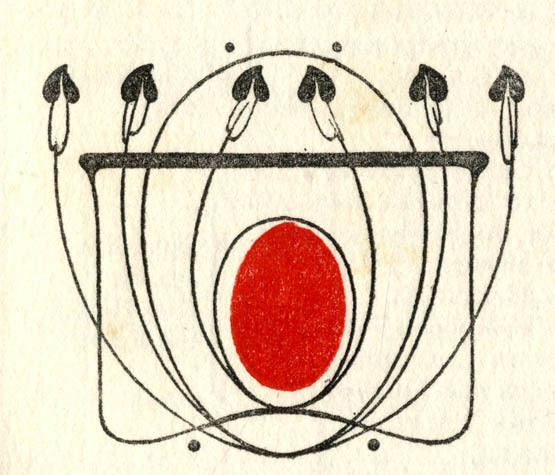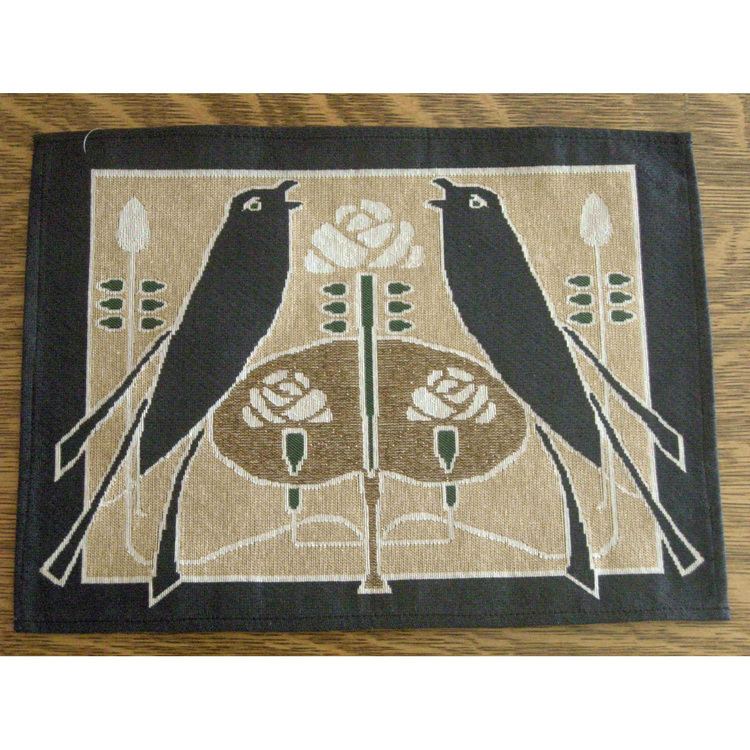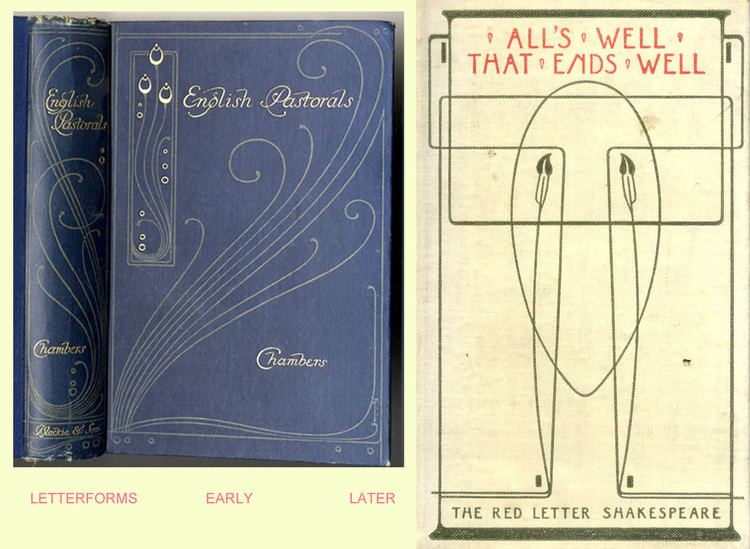Nationality British Name Talwin Morris Known for Book design | Occupation Designer Other names Talwyn Morris | |
 | ||
Died March 29, 1911, Bowling, United Kingdom | ||
Talwin Morris (15 June 1865 – 29 March 1911) was a prolific book designer and decorative artist working in the late 19th and early 20th centuries, particularly known for his Glasgow Style furniture, metalwork and book designs.
Contents
- Early life and career
- Move to Glasgow
- Exhibiting career
- Influence on Book Design
- Death and Posthumous Reputation
- Notable Collections
- References

Early life and career

Morris was born 15 June 1865 in Winchester, England to auctioneer Thomas Shewell Morris (1832–1877) and Harriet Chick (d.1865 in childbirth).

Upon his father's death in 1877 he was placed in the guardianship of his uncle Joseph Morris (1836–1913) and aunt Emily (1829-1916) in Reading, Berkshire. Chosen for a theological career by Emily, from September 1880 he attended Second's House of Lancing College in West Sussex before withdrawing from his studies in April 1882. Between 1882 and 1885 he was articled to his uncle's architectural film Morris & Smallwood, winning a prize in 1885 from the Berkshire Archaeological and Architectural Society. Following his apprenticeship, he obtained work in London between 1885 and 1890 with architect James Martin Brooks (1859-1903). Despite this training he seems not to have registered with the Royal Institute of British Architects.

From 1891 he took up post as sub art-editor under M. H. Spielmann for Black and White, a weekly magazine published by Cassell, designing many of its decorative initials and headpieces. By 1892 he had also designed the masthead of Cassell's Saturday Journal. Around this time he was sharing rooms in Belle Vue Road, Kingston upon Thames with his second cousin, the miller and collector Ernest Marsh (1843-1945). On 21 May 1892 he married another second cousin Alice Marsh (1861–1955), daughter of Joseph and Ellen Grace Marsh, who went on to enjoy her own highly successful career as an illustrator of children's books under the name Alice Talwin Morris. His occupation on the marriage certificate is listed as 'clerk'. They lived at 1 Field Court, Gray's Inn, London, a short walk from the offices of Black & White on Bouverie Street.
Move to Glasgow

Responding to an advertisement placed in The Standard on 21 February 1893 for an Art Director for publishers Blackie and Son, he moved to Glasgow in May 1893. In later years Agnes Blackie recalled "the appointment in 1892 [sic.] of a disciple of art nouveau, Talwin Morris, as head of the art department, had tangible effect, not only on the design of book covers, but on the appearance of the office at 17 Stanhope Street" [the Blackie offices]. Morris soon made the acquaintance of the artists and designers associated with the Glasgow School of Art via Robert Blackie (1820-1896) who sat on the committee of the School from 1871-1892. Although he never attended the School, Morris soon became friends with Charles Rennie Mackintosh and his contemporaries, and his own work quickly began to incorporate Glasgow Style motifs.
Responding to an advert of 1 March in the Glasgow Herald, he and Alice leased Dunglass Castle on the Auchentorlie Estate from July 1893 and began to design its interiors. Morris is also known to have been a keen collector of Martinware ceramics, a passion he shared with his cousin Ernest Marsh. Bookplates designed by Talwin and Alice at that time are generally thought to reflect the circumstances of their new home and life together. The house was sold in July 1899 to the parents of his friends Margaret and Frances Macdonald, and the Morrisses moved to the newly-built Torwood in Bowling, West Dunbartonshire where Morris could enjoy a garden studio. Morris's Dunglass interiors were subsequently completely remodelled for the Macdonalds by Mackintosh. Today, Dunglass is derelict and classified as a Building at Risk.
In 1902 he introduced Charles Rennie Mackintosh to his employer Walter Blackie, which led to Mackintosh receiving the commission to design Blackie's home, Hill House, Helensburgh. In 1910, Morris designed the memorial of his employers the Blackie Family in Glasgow Necropolis, which was then carved by John Mossman.
Exhibiting career
From 5 October-5 December 1896 Morris exhibited three book cover designs (The Universe, English Essays, and Daddy Samuel's Darling) at the fifth exhibition of the Arts and Crafts Exhibition Society at the New Gallery, London. In November–December 1900 he joined Mackintosh and others to exhibit a pressed bronze mirror at the eighth exhibition of the Vienna Secession, organised by the Vereinigung Bildender Künstler Österreichs and curated by Josef Hoffmann. Here his work was shown in room I as opposed to room X which housed the work of Mackintosh and other Glasgow artists. He also exhibited at the 1902 exhibition of British arts and crafts at the Museum of Applied Arts (Budapest). In the same year his work was selected for exhibition alongside those of his contemporaries at the influential Prima Esposizione Internazionale d'Arte Decorativa Moderna held in Turin, at which he sold four beaten metal mirrors and a bookbinding. The 'Scottish Section' had been organised by Francis Henry Newbery, Headmaster of Glasgow School of Art and consisted mostly of Glasgow artists across a suite of three rooms designed by Charles Rennie Mackintosh.
Influence on Book Design
Morris became hugely influential in Victorian book design by moving away from the popular narrative bindings of the time to a more modern Art Nouveau approach where line, curve and decoration are used to entice the reader. The book designs of Dante Gabriel Rossetti have been cited as a particular influence. At Blackie and Son his output was prolific, producing many designs that could be printed in different colourways across series such as the Red Letter Library and Library of Famous Books. He also designed books for Morison Brothers of Glasgow, Cassell, J. G. Cotta of Stuttgart, J. C. C. Bruns of Minden, F. Volckmar, Mudie's Select Library, and from 1898 the Blackie subsidiary Gresham. In 1906 he also supplied the cover design of the influential German magazine Dekorative Kunst. Though many of his book designs are unsigned, some feature his 'signature' of a single dot followed, after a pause, by a further two dots (a stylised rendition of his initials in morse code which would consist of a long dash followed by two shorted dashes). Others feature a stylised elongated TM monogram. During his tenure, Morris also commissioned book designs by designers such as Ethel Larcombe and Silver Studio.
Death and Posthumous Reputation
Morris retired through ill-health in 1909 and died from a cardiac embolism on 29 March 1911 at just 45 years old. His one piece of formal writing, the 9th special supplement of the Press Art School titled 'The Illustration of Children's Books', was published posthumously in 1912. His body lies in Dumbarton Cemetery, marked by a gravestone designed by his friend Charles Rennie Mackintosh at the behest of his widow Alice. The inscription reads "Love is more great than we conceive / and death is the keeper of unknown redemptions", taken from the Dominion of Dreams (1899) by Celtic Revival writer Fiona Macleod, a pseudonym of William Sharp. This quotation had previously been used for Macleod's own memorial.
In 1911 and again in 1924 books in the possession of his widow Alice were auctioned at Sotheby, Wilkinson & Hodge. In 1939 Alice presented the 1896 Charles Rennie Mackintosh watercolour 'Part Seen, Part Imagined', originally purchased by Morris at the 1896 Arts and Crafts Exhibition Society and now in a Morris frame of beaten metal, to the Kelvingrove Art Gallery and Museum. In 1946 further gifts of architectural drawings, interior designs and sketchbooks of Blackie motifs followed. Some of his design work for Blackie was sold at Sotheby's in 1989 in the sale of their archives. A grille and stained-glass window for the Blackie headquarters at 17 Stanhope Street, Glasgow (demolished in the 1960s) was sold the following month at Christie's.
Posthumous exhibitions of Morris's work were held at the William Morris Gallery, London from 23 August-2 October 1983, National Art Library, London from June–July 1990, Blackwell, Lake District from 26 April-11 July 2005, University of Reading from 12 January-20 March 2009, and Court Barn Museum, Chipping Campden from 3 April-17 May 2015. His work can be seen in many library and museum collections, both in the United Kingdom and internationally.
